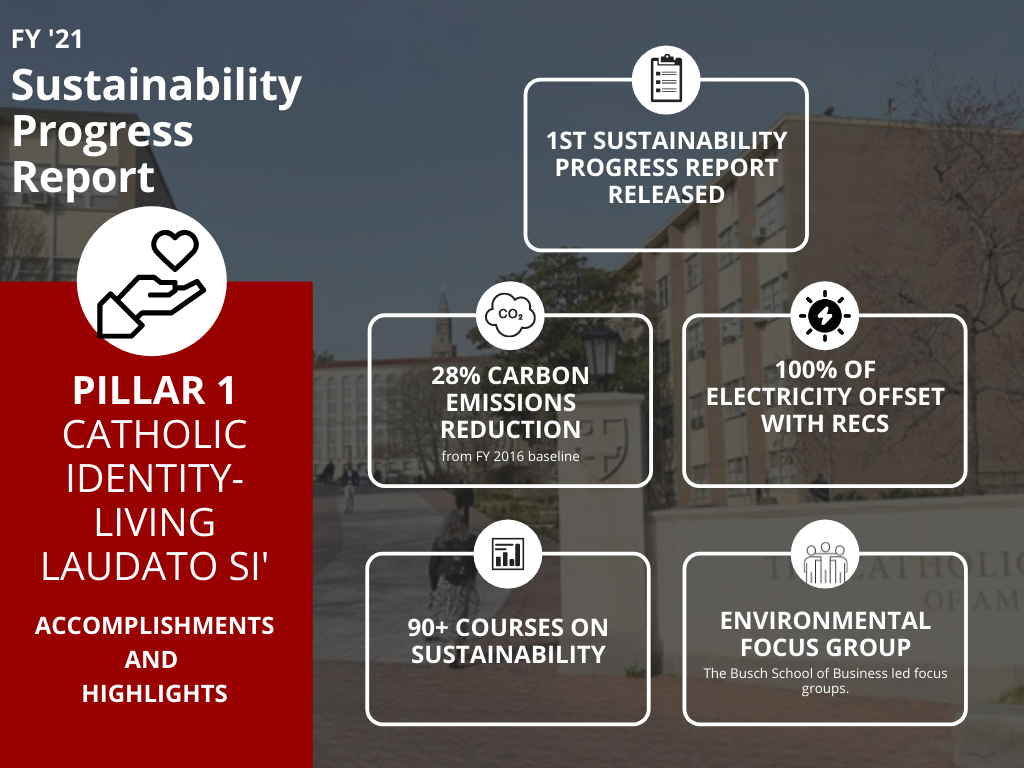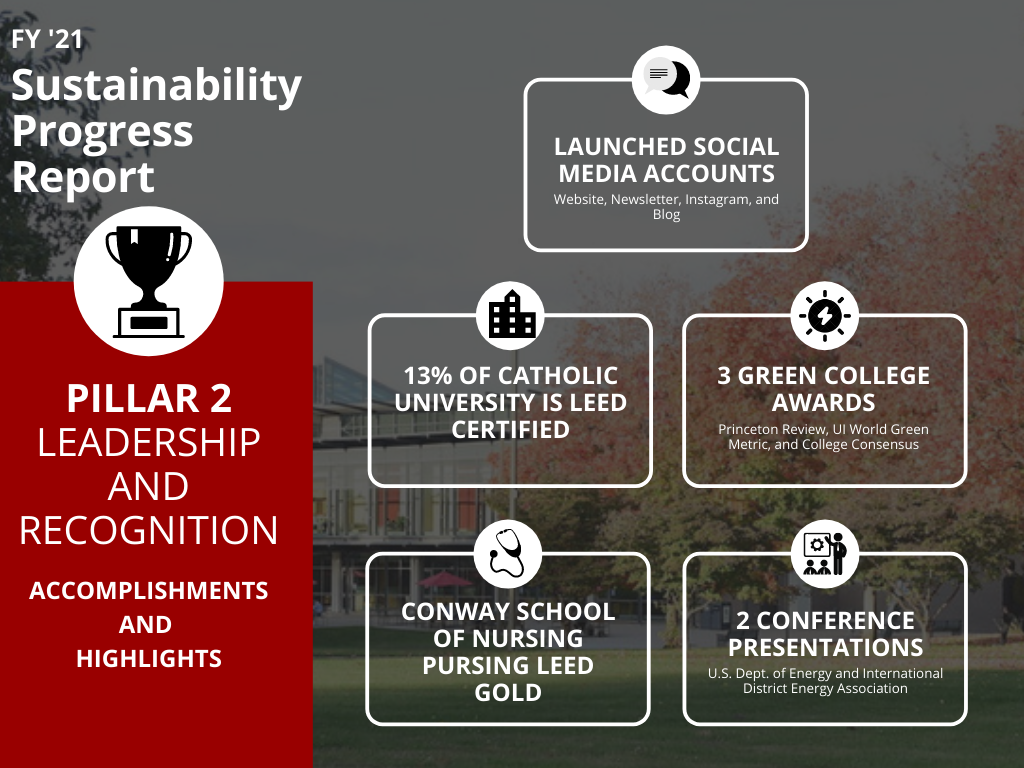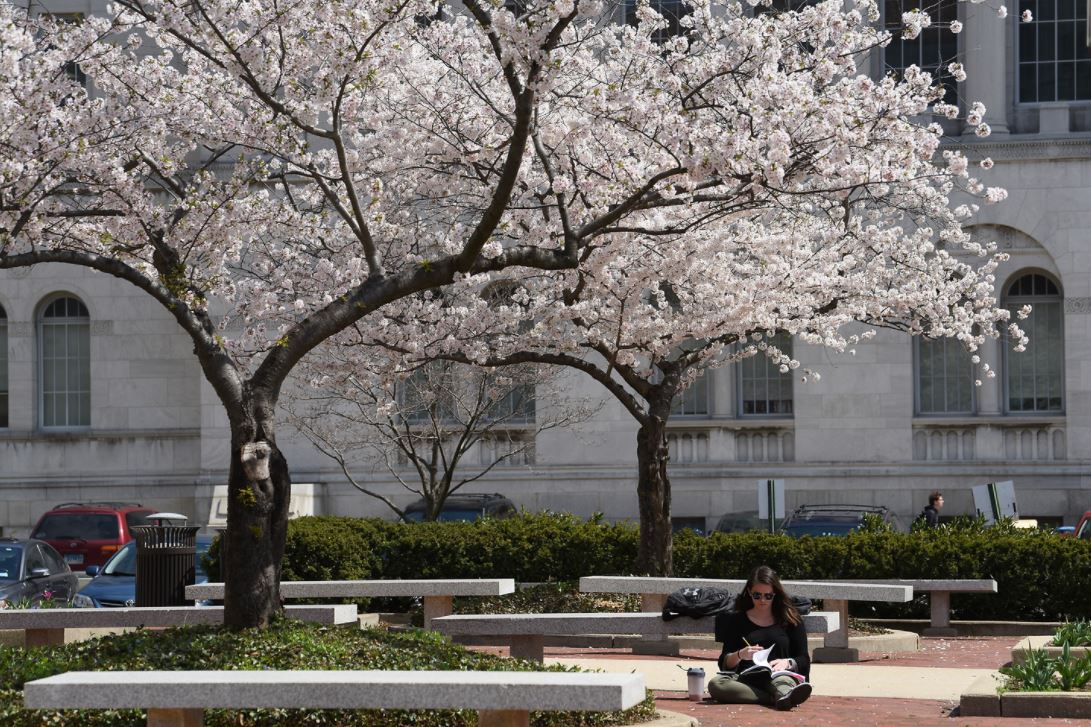In Fall 2020, the University released a 5-year sustainability plan. The plan is inspired by programs implemented at similar higher-education institutions. The initiatives and actions listed in the plan are intended to generate positive environmental change, promote education and research, preserve resources, raise awareness, reduce expenditures, generate exciting dialogue, and create new Catholic University community engagement touchpoints.
Nearly a year after its release, the University has made significant progress on sustainability initiatives.
Environmental Progress During a Challenging Year
In FY 2021, the University re-demonstrated its commitment to safeguarding a sustainable environment on campus. Academic and facility-level efforts established a foundation for environmental stewardship at Catholic University. New efforts challenged all stakeholders – students, faculty, staff, parents, alumni, and the community – to take on bolder, inclusive, and equitable initiatives in line with contemporary best practices to preserve the University’s legacy for future generations.
Major developments in FY 2021 included the conclusion of the Energy Project, which yielded a major downward trend in water and energy use on campus; the release of the 5 Year Sustainability Plan; and accolades and recognition on national and international platforms. Due to infrastructure improvements such as the Energy Project and a 100% electricity offset, the University met its carbon emissions, energy reduction, and water reduction goals, and set new goals to drive more ambitious savings. Despite the operational challenges due to COVID-19, many initiatives pressed forward on campus including new ways to engage students around sustainability and the completion of a solar feasibility study.
This Progress Report provides a summary of where the university stands on each of its 98 sustainability initiatives included in the 5-year plan. To see a detailed analysis of each initiative, email sustainability@cua.edu for access to the initiative tracker. The current plan runs from FY 2021 to 2025. As a reminder, the initiatives in the plan correlate to the four guiding pillars below.


-
Highlights
- Launched sustainability website, newsletter, social media accounts, and blog.
- Delivered 2 conference presentations.
- Initiated 2 organizational partnerships on sustainability.
- Pursuing LEED Gold for the new nursing and sciences building.
- 13% of Catholic University is LEED certified.
- Recognized by 3 organizations for sustainability best practices:
- 21st Best Green College – College Consensus.
- 19th Sustainable Campus in the U.S. – UI World Green Metric.
- 557th Sustainable Campus in the World – UI World Green Metric.
- Green College – Princeton Review.
-
New Recognition
Catholic University was recently recognized for its dedication to sustainability by three college-ranking websites.
Catholic University was included in the Princeton Review’s Guide to Green Colleges: 2021 Edition. Institutions were presented with green rating scores based on their sustainability-related policies, practices, and programs. Catholic University’s score earned it a spot on the list of 416 Green Colleges.
College Consensus ranked the University as 21st on a list of the Best Green Colleges in the United States to recognize Catholic U’s embrace of renewable energy.
Indonesia’s UI World Green Metric ranked the University the 19th most sustainable campus in the U.S. and the 557th most sustainable campus in the world. The University earned high marks for access to quality alternative transportation, energy and climate change action, and waste management.

-
Highlights
- Achieved a 25% energy reduction compared to FY 2016 levels.
- Achieved a 35% water reduction compared to FY 2016 levels.
- Drafted a Zero Net Energy Plan.
- Installed new energy efficiency measures on campus including:
- Heating and cooling upgrades at Centennial Village.
- New windows and doors at Caldwell Hall-Seaton Wing.
- Pool equipment upgrade at DuFour Center.
- Completed a solar feasibility study.
- Achieved a 29% ongoing-consumables diversion rate.
- Launched a composting pilot at the Pryzbyla Center.
- Promoted health and wellness through Dining Services.
- Upgraded indoor air quality protocols.
- Developed new on-demand fitness programs.
- Pursuing WELL certification for the new nursing and sciences building.
- Cardinal Cupboard food pantry increased availability with a presence in the Pryzbyla Center.
- Students can take advantage of the Capital Bikeshare discount.
- Planted 60+ trees.
- The planned Welcome Plaza will enhance the formal landscape qualities on campus.
- University re-certified under Tree Campus Higher Education.
-
Improving Indoor Air Quality
In FY 2021, the University created a Return to Campus Plan to reduce the risk of COVID-19 transmission with guidance from the DC Department of Health, the Centers for Disease Control and Prevention (CDC), the U.S. Environmental Protection Agency (EPA), and industry and professional organizations such as the American Society of Heating, Refrigeration, and Air Conditioning Engineers (ASHRAE).
In addition, based on guidance aimed at potentially reducing risk from the possibility that spread may also occur via airborne particles in indoor environments, the Facilities Planning and Management team evaluated building systems and indoor air quality conditions in all campus buildings with the support of consulting architects and engineers. Based on their recommendations, improvements were implemented where feasible to potentially further reduce transmission risk.
Recommendations to mitigate the risk of airborne spread included increasing ventilation with outdoor air, optimizing air exchange rates, and improving air filtration, among others. These mitigations, aimed at improving ventilation and filtration, vary by building but may include: provision of additional outside air, keeping systems running longer than normal, upgrading system filters to the highest grade compatible with the existing equipment, and the use of mobile, self-contained filtration units. In some cases, during temperate weather conditions, using operable windows increased outdoor air into spaces.
Modifications to our HVAC systems and operations were considered additional layers of a larger strategy that included these essential fundamentals: social distancing that reduces the occupancy load, wearing face coverings, increased surface cleaning, and frequent hand washing.
Additionally, the traffic flow in buildings was examined. Especially in high-traffic areas, directional signage was placed on floors and stairways to help promote social distancing as people move through the buildings. In buildings with multiple stairwells, some were designated as “up” or “down” paths.
New cleaning and disinfection procedures were adopted at the onset of the pandemic and have continued to evolve with guidance from the CDC.
These improvements kept the campus community safe and functioning.
-
The Energy Project and Campus Reduction Goals
Thanks to a three-phase project begun in 2016, the Catholic University campus is now running more smoothly and efficiently. The Energy Project converted the steam-based heating and cooling system on campus to a more efficient hot/chilled water system. The drastic renovation changes the energy distribution, improves efficiency at the Power Plant, and lowers operating costs.
The new, efficient hot/chilled water loop reduces losses in heating and cooling. The reduction in cooling and heating losses saves the University in utility costs and helps it meet broader sustainability goals.
The project began and ended at the Power Plant. It started with the replacement of old steam boilers with high-efficiency hot water boilers and the installation of a new central chiller plant. Then, the project snaked around campus with the installation of below-grade piping and utility lines to distribute utilities to all campus buildings. The goal was to improve the heating and cooling of the buildings and renovate the Power Plant.
The new energy-efficient, state-of-the-art central heating water system includes 12 high-efficiency condensing boilers, variable flow distribution pumps, and an optimized control system. Direct buried and highly insulated steel piping with digital leak detection delivers hot and chilled water to campus buildings. Contractors installed 52,800 linear footage of heating and chilled water piping through campus to provide efficient cooling and heating.
The Power Plant, originally constructed in 1910, houses the new modern heating water system and the new central chiller plant. The new central chiller plant produces and provides chilled water to most campus buildings, replacing numerous stand-alone chillers in buildings that currently are air-conditioned. In buildings that are not yet air-conditioned, the connection to the new chilled water plant will enable air conditioning to be installed more easily over time and as funding allows. In the future, the Dining Commons and Conway School of Nursing will also connect to the chilled water plant.
The project includes new "smart" electrical infrastructure and system controls to support the new central heating and cooling systems. In addition, a stormwater harvesting cistern and filtration system collect rainwater for use in three cooling towers. The cistern can hold 15,000 gallons of water and the expected water savings are 270,226 gallons per year. An energy-efficient emergency generator installed outside the Power Plant provides backup power in the event of a loss of electricity on campus. The Energy Project also includes an autonomous system that continuously tracks the state of the machine as well as the system.
From the project's beginning in 2016 through 2020, the university reduced its energy usage by 22% and reduced water usage by 39%. On average, this nets the University nearly $1.24M in utility savings.
-
Tree Campus Certification
The Catholic University of America was honored with a 2020 Tree Campus Higher Education® recognition by the Arbor Day Foundation for its commitment to effective urban forest management. The Tree Campus Higher Education program honors colleges and universities for effective campus forest management and engaging staff and students in conservation goals.
To earn recognition, the University relaunched a series of initiatives, including a tree committee. The tree committee includes staff from facilities planning and management, students from the Student Government Association, staff from Campus Ministry, staff from the School of Architecture and Planning, and the local tree canopy advocacy non-profit Casey Trees. The committee meets at least quarterly and meetings are open to any interested community members. Recertifying the campus and establishing new opportunities for students to learn about tree care were essential to the tree committee.
In Fall 2020, the University hosted an educational tree webinar with Casey Trees on the history of trees planted on campus and the District of Columbia’s goals on increasing the tree canopy. In Spring 2021, the Tree Committee hosted a Spring Tree Walk.

-
Highlights
- Established 1 new service site with the Franciscan Monastery.
- Broke ground on new campus community garden.
- Hosted 5 episodes of the Wisdom Wednesday webinar series.
- Facilitated 4 new classroom collaborations between the Facilities division and the Schools of Architecture and Planning, Engineering, and the Busch School of Business.
- Established Tree Committee with students, faculty, staff, and Casey Trees.
- Participated in nationwide waste competition with student and cross-departmental involvement.
- Hosted 1 sustainability internship.
- 15 student-led events for Earth Day.
- 1 new student club on sustainability.
- Student Government Association launched an environmental initiative with a close partnership with Facilities Planning and Management.
-
A New Community Garden: Students Taking the Lead on New Initiatives
In FY 2021, new student organizations and student government association (SGA) initiatives focused on bringing environmental awareness to campus and the outdoors. Students re-introduced the community garden to campus and played an integral role in re-certifying the campus under the Tree Campus Higher Education program.
This academic year, Catholic U’s SGA created an environmental initiative. The initiative is comprised of an initiative director and three associate directors who act as liaisons with the Facilities Management and Operations office to collaborate on sustainability and student engagement strategies. Creating a new community garden at Curley Hall was a top priority for the new initiative. The new community garden allows community members to foster a raised bed plot for a growing season. The garden is managed by garden liaisons who help educate other students, faculty, and staff on how to manage their plots. The initial pilot started in March 2021.
-
Earth Day 2021
In April 2021, Earth Day shed light on how climate change is impacting the communities we touch. Whether it is Catholic University’s home in Washington, DC, our hometowns, or communities half a world away, communities are on the frontline of a rapidly changing climate. Equitable solutions are needed for access to clean air, clean water, clean energy, healthy food, and climate mitigation. Events explored how the Church, businesses, technology, cities, and designers are responding to these challenges and the people they impact.
Earth Day was the biggest celebration on campus in years. More than 10 campus organizations held 15 events raising environmental awareness on campus. Students came together virtually or in-person to learn about the day’s most pressing environmental issues. Events included a day-long community service day, a student-led virtual teach-in series, an Earth Day lunch, conversations on Laudato Si’ , and a performance by an environmentally-conscious comedienne.
Impact
The Sustainability Plan FY 2021-2025 challenges the University to achieve 5-year outcomes. Below is a summary of the latest environmental key performance indicators. Fiscal year 2016 is used as the baseline for the indicators as it was the last full year of data before the University began construction on the Energy Project. Indicators were tracked on at least a quarterly basis through utility bill analysis, sub-metering platforms, and other data outputs.
 Carbon Emissions Reduction
Carbon Emissions Reduction
- Baseline: 20,811 metric tons of carbon dioxide equivalent (MtCDE), FY 2016.
- Goal: 20% reduction is equal to 4,162 MtCDE averted which could charge 506 million smartphones or power 501 homes*.
- FY 2021 Progress: The University reached this goal. In FY 2020**, the University reduced its emissions 28% compared to the baseline, which is equal to 5,759 MtCDE averted.
- New FY 2025 Goal: Reduce carbon emissions by 40%.
** FY 2020 is the latest carbon emissions data available.
Energy Reduction
- Baseline: 249,713 million British Thermal Units (MBTU), FY 2016.
- Target: 20% reduction is equal to 49,943 MBTU’s saved, which is equal to the CO2 emissions from 760,932 gallons of gasoline consumed or the greenhouse gas emissions from 1,436 vehicles or $0/46/SF.
- FY 2021 Progress: The University reached this goal. In FY 2021, the University reduced its energy use 25% compared to the baseline.
- New FY 2025 Goal: Reduce energy by 30%.
Ongoing Consumables Reduction and Diversion
- Baseline: 38% of 1,401 tons of waste diverted from the landfill, FY 2016.
- Target: 50% diversion is equal to 700 tons removed from the landfill, which could save 143,048 hours of electricity or 25,871 gallons of oil.
- FY 2021 Progress: The University diverted 29% or 186 tons of waste from the landfill. This was a slight improvement over FY 2020 which had a diversion rate of 25%.
Water Reduction
- Baseline: 73,217 thousand gallons (kgals), FY 2016.
- Target: 20% reduction is equal to 14,643 kgals saved, which is enough water to fill 22 Olympic-sized pools or save $0.04/SF.
- FY 2021 Progress: The University reached this goal. In FY 2021, the University reduced its water use 35% compared to the baseline, which is equal to 25,316 kgals or $0.06/SF saved. This is the water equivalent of 38 Olympic-sized swimming pools.
- New FY 2025 Goal: Reduce water usage by 50%.
FY 2022: Look Ahead
Catholic University has made great strides on a number of sustainability initiatives. In Fiscal 2022, new initiatives and actions will focus on:
- Developing a suite of university-based best practice plans focused on hardscape management, and integrated pest management plans.
- Creating five-year plans for energy and zero waste.
- Establishing new touchpoints between faculty, staff, and students on the Church’s teachings on environmental stewardship.
- Achieving a new Green Restaurant Certification and AASHE STARS rating.
- Reducing waste sent to the landfill through occupant awareness to achieve 5-year objectives.
- Implementing native and adaptive plants into the campus landscape.
- Implementing facility management best practices during residence hall move-outs.
- Codifying a sustainable design standard.
- Developing a green residence hall move-out program.
- Engaging staff, alumni, and prospective students on the University’s sustainability initiatives.

